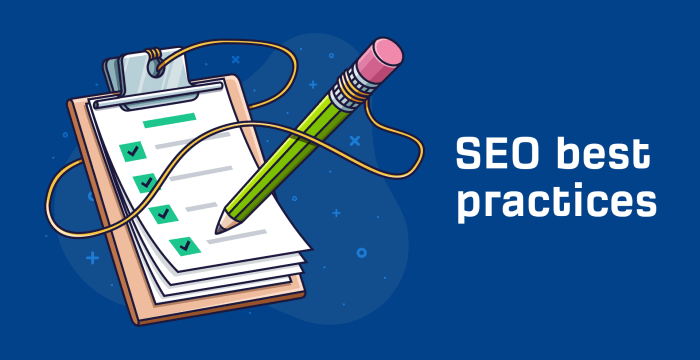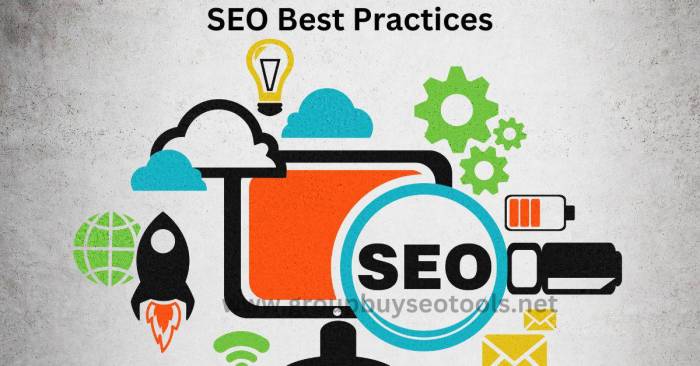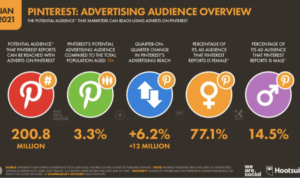SEO Best Practices – Best Practices kicks off the ultimate guide to optimizing your website for maximum search engine visibility and ranking. Get ready to dive into the world of and take your online presence to the next level!
Best Practices
best practices are like the secret sauce that makes your website pop on search engines like Google, Bing, or Yahoo. They are a set of techniques and strategies that help optimize your website so it can be easily found by users searching for relevant information. Following best practices is crucial for improving your website’s visibility, driving organic traffic, and ultimately boosting your search engine rankings.
Key Components of Best Practices
- Research: Identifying the right s to target in your content
- On-Page Optimization: Optimizing meta tags, headings, and content for targeted s
- Quality Content: Creating valuable and engaging content that resonates with your audience
- Mobile Optimization: Ensuring your website is mobile-friendly for better user experience
- Link Building: Building high-quality backlinks from reputable websites to improve authority
How Best Practices Improve Search Engine Rankings
best practices work like magic to tell search engines that your website is legit and relevant. By optimizing your website with the right s, quality content, and solid backlinks, you’re basically shouting to search engines, “Hey, check me out, I’m the real deal!” This increased visibility and credibility can lead to higher search engine rankings, meaning more eyes on your website and potentially more business for you.
Examples of Successful Implementation
Take a look at how XYZ Company skyrocketed to the top of Google search results by implementing a solid strategy and consistently creating valuable content that resonated with their target audience.
Another great example is ABC Blog, which saw a significant increase in organic traffic after optimizing their website for mobile and building strong backlinks from reputable websites in their industry.
On-Page Optimization: SEO Best Practices

On-page optimization plays a crucial role in by helping search engines understand the content of a webpage and rank it accordingly. It involves optimizing various elements on a webpage to improve visibility and relevance in search results.
Optimizing Meta Tags, Headings, and Content
Meta tags, headings, and content are key areas to focus on for on-page optimization:
- Meta Tags: Ensure that meta title and description accurately reflect the content of the page and include relevant s.
- Headings: Use H1, H2, and H3 tags to structure the content logically and include primary s in headings.
- Content: Create high-quality, relevant, and engaging content that incorporates s naturally throughout the text.
Tips for Improving Site Speed and Mobile Responsiveness
Improving site speed and mobile responsiveness are crucial for on-page :
- Optimize images and minify CSS and JavaScript to reduce page load times.
- Utilize responsive design to ensure your website looks great and functions well on all devices.
- Use Google’s PageSpeed Insights tool to identify and fix performance issues on your website.
Examples of Websites with Effective On-Page Optimization, SEO Best Practices
Some websites that have effectively implemented on-page optimization techniques include:
- HubSpot: HubSpot’s website has well-optimized meta tags, headings, and content that help it rank highly in search results.
- Moz: Moz’s website is optimized for speed and mobile responsiveness, providing a seamless user experience across devices.
- Neil Patel: Neil Patel’s website features high-quality content that is strategically structured with headings and s for optimal performance.
Off-Page Optimization

Off-page optimization refers to the actions taken outside of your own website to impact your rankings within search engine results pages. This includes building quality backlinks from other reputable sites to increase your site’s credibility and authority in the eyes of search engines.
Importance of Building Quality Backlinks
Building quality backlinks is crucial for off-page as search engines like Google consider backlinks as a vote of confidence from other sites. The more high-quality backlinks you have, the more authority and credibility your site will have in the eyes of search engines, which can lead to higher rankings in search results.
- Focus on creating valuable and relevant content that naturally attracts backlinks from other sites.
- Reach out to influencers or other websites in your industry to collaborate on content or guest posting opportunities.
- Utilize social media platforms to share your content and attract more backlinks.
- Submit your site to online directories and industry-specific websites to gain more visibility and backlinks.
- Monitor your backlink profile regularly to ensure that you are receiving quality backlinks and disavow any toxic or spammy backlinks that could harm your site’s reputation.
Examples of Successful Off-Page Optimization Campaigns
– Airbnb’s creative PR campaigns and partnerships with influencers to generate high-quality backlinks.
– Moz’s comprehensive guides and resources that attract natural backlinks from industry professionals.
– Nike’s sponsorship of major events and athletes to gain exposure and backlinks from sports-related websites.
Technical
Technical refers to the optimization of a website’s technical aspects to improve its search engine visibility and performance. It plays a crucial role in ensuring that search engines can crawl and index a site effectively, leading to higher rankings and increased organic traffic.
Website Structure and Significance
Website structure is a fundamental aspect of technical as it helps search engines understand the content and hierarchy of a site. A well-organized site with clear navigation can improve user experience and search engine rankings. Sitemaps and robots.txt files are essential components that help search engines crawl and index a site efficiently. Sitemaps provide a roadmap of all pages on a site, while robots.txt instructs search engine bots on which pages to crawl or not crawl.
Optimizing Website Speed and Mobile-friendliness
Website speed and mobile-friendliness are crucial factors for technical . A fast-loading site not only improves user experience but also positively impacts search engine rankings. Optimizing images, minifying CSS and JavaScript, and using caching mechanisms can help improve website speed. Mobile-friendliness is equally important, as more users are accessing websites on mobile devices. Responsive design, mobile-friendly content, and AMP (Accelerated Mobile Pages) implementation are essential for ensuring a positive mobile user experience.
URL Structure Optimization
URL structure optimization involves creating -friendly URLs that are descriptive, concise, and contain relevant s. A clear URL structure not only helps search engines understand the content of a page but also improves user experience by providing a clear indication of the page’s topic. Avoiding long, complex URLs, using hyphens to separate words, and including target s in the URL can help improve search engine rankings.
Case Studies
Several websites have experienced significant improvements in their search engine rankings through technical enhancements. For example, a travel website that optimized its website speed saw a 30% increase in organic traffic within a month. Another e-commerce site that implemented mobile-friendly design reported a 20% increase in conversions from mobile users. These case studies demonstrate the importance of technical in achieving better search engine visibility and performance.





